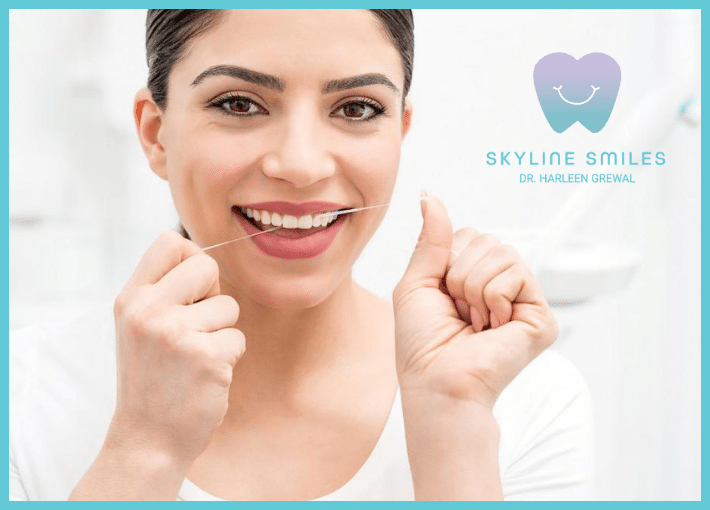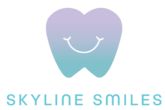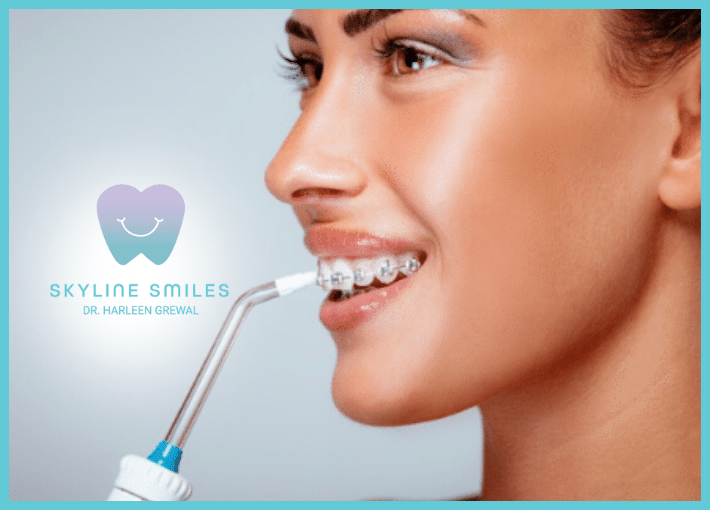Who wants to bother with the task of flossing? Not many people, from what studies show. But if you are one of those folks who skip the floss as part of your daily oral hygiene routine, you are putting your teeth (and overall health!) at greater risk than you might think. Getting into the habit of flossing is a better course of action than dealing with the consequences of not flossing further down the road — here is a helpful article to get you started on the proper path!
If you feel guilty because you don’t floss your teeth, at least you’re in good company. Studies say that only three in 10 Americans floss regularly, even though it’s the best way to remove up to 80% of the plaque that’s lurking between your teeth. Yes, regular tooth brushing is important, but so is flossing, and doing both together on a regular basis can have a significant impact not just on your oral health, but on your overall health, too.
Why Flossing Matters
Regular flossing removes the bacteria in plaque, called biofilm, which can contribute to decay between teeth and lead to periodontal disease. But those plaque build-ups aren’t just bad for your teeth. “Dental plaque can make diabetes harder to control, and there’s evidence that it contributes to heart disease,” said registered dental hygienist Marie Paulis, the dental hygiene program director at the University of New Haven.
Researchers have cause to believe that gum disease can travel throughout the body, triggering inflammation in the heart’s vessels and infection in heart valves. It’s also been linked to strokes, diabetes complications, and respiratory issues.
“Research also indicates that the presence of dental plaque in pregnant people can contribute to preterm births or low birthweight babies,” Paulis said.
And if things get bad enough, you might even end up with a syndrome known as “leaky gums,” which dentist and prosthodontist Dr. Jonathan B. Levine described this way: “If you don’t mechanically remove bacteria so it doesn’t build up, it can create a no-oxygen environment that causes bad bacteria to outgrow and colonize the good bacteria and lead to gum inflammation. Once that inflammation in the mouth becomes chronic, the bad bacteria can enter the rest of the body through what’s known as leaky gums.”
Finally, if avoiding leaky gums isn’t enough motivation for you, try putting your hand in front of your mouth and giving that breath a quick check. “The most common cause of bad breath is waste from bacteria, dead skin cells and food particles in the mouth,” said cosmetic dentist Dr. Brian Harris. “Flossing allows you to remove them, which will give you fresher breath.”
Don’t Bother Lying To Your Dentist
If you’re trying to convince your dentist that you’re a regular flosser when you really aren’t, don’t waste your time. After just one “open wide” look into your mouth, they can tell. “Typical signs include tartar buildup between the teeth, decay between the teeth and redness or swelling in the gums in the space between the teeth,” Paulis said.
And when it comes to offering up excuses, dental health professionals have pretty much heard it all. The experts we talked to said top patient excuses include lack of time, difficulty with the process, and failure to get into the rhythm of a routine.
Step One: Buy Some Floss
“The best kind of floss is the one you’ll use regularly,” Harris said. “The most important thing is to find the best option for you and stick with it.” He did have views on the effectiveness of different thicknesses: “The most effective variety is thicker and woven, which will always remove more bacteria and clean the teeth better than thin floss,” he said.
Harris also suggested trying a few brands and styles to see what works for you. “For some people, floss picks work because they’re convenient and easier to use,” he said. “For others, fancy floss with good flavors enhances their experience and gets them excited about flossing. If you lack hand or finger dexterity, then a water flosser might be ideal.”
Step Two: Get Into The Habit

“I usually tell patients that it takes a month or two to have a new habit become routine,” Paulis said. “When they first try to incorporate flossing into their routine, I recommend making it as easy as possible, perhaps by keeping the floss in a prominent area or wherever they’re likely to relax and have a few spare moments.”
Levine suggested: “Try putting a note to yourself on your bathroom mirror, reminding yourself why you want to floss.”
Eventually, the experts said, it will all be second nature. “Once you successfully make flossing part of your routine, it will become something you don’t need to actively try to remember to do,” Levine said. “You’ll actually feel it in your mouth if you forget to floss one day, because it just feels better when you do.”
- Oral-B Genius 6000 electric toothbrush
Dr. Aierress Davis, a dentist in Augusta, Georgia, named this toothbrush as her favorite because of its price point and the slew of necessary features you’ll want in an electric toothbrush.
“Your toothbrush should have a pressure indicator to let you know when you’re brushing too hard. On the Oral B Genius 6000, the pressure indicator turns red and slows the speed of the brush if you’re brushing too aggressively during use. This is perfect to prevent things like gum recession or trauma!” Davis said.
She also likes the ability to replace the brush heads. “These should be replaced every 3 months for optimal cleaning. My personal preference is a circular brush head, and my most favorite to use is the Cross Action heads,” she said.
- Oral-B iO Series 9 electric toothbrush
Dr. Angela Abernathy, a dentist at New York City’s Boutique Smiles, said she currently uses the series 9 model of Oral-B’s iO electric toothbrush.
“I really like the electric brushes because they have technology that prevent you from brushing too hard. If there is too much pressure, the brush will either stop or stall to prevent damage to your teeth and gums. Also, the iO has a light around the head that will turn red if there is too much pressure, blue if there isn’t enough pressure and green if the pressure is just right. They also have timers that make sure you are brushing for at least two minutes. One other thing I like about the iO is that there is an app you can download to sync with your phone and evaluate your brushing over time. I especially highlight this feature for my patients,” Abernathy said.
- Oral-B Genius 9600 electric toothbrush
Dr. Judy Yip, a pediatric dentist at Lollipop Dental in Garden Grove, California, is a fan of the Genius 9600 model.
“There are so many built-in features that help you build healthy oral hygiene habits, such as a small round brush head that allows you to get into hard-to-reach areas, a built-in brushing timer that indicates how long you should be brushing and my favorite feature is the pressure indicator that lights up when you are putting too much pressure on your gums — a total game changer since most people are not aware that they are brushing too hard,” Yip said.
- A pack of Colgate Extra Clean soft toothbrushes
While electric toothbrushes remain a popular choice for dental hygiene, Dr. Joke Alesh, a Rhode Island-based dentist, opts for Colgate’s soft-bristled manual toothbrush.
“It comes in a low-cost 6-pack and I buy them in bulk so I can change my toothbrush monthly. When it comes to tooth brushing, the most important thing to me is the bristles. Flattened, worn bristles do not effectively displace plaque. I know I wouldn’t change expensive or complicated brush heads as often,” Alesh said.
- Oral-B iO Series 8 electric toothbrush
Florida dentist Dr. Jordan Brown reaches for the series 8 model of Oral-B’s iO collection, which has a “super sensitive” pressure setting.
“I use the Oral-B iO series 8 electric toothbrush because it has an app I use to live-track my brushing, it has a built-in pressure sensor and it has a timer,” Brown said.
- Oral-B iO Series 6 electric toothbrush
This Oral-B iO model features five cleaning modes — daily clean, sensitive, intense, whitening and gum care — and is used by Dr. Aaleeyah P. Alim, a Rockford, Illinois-based dentist.
“The round head cleans the gum line so nicely. I can always feel the difference as opposed to when I have used other toothbrush shapes. I’m generally a fan of electric toothbrushes over manual because they commonly offer a built-in timer to make sure we are brushing the full two minutes, as well as extra movement to disturb the layer of plaque that forms on the teeth throughout the day and night,” Alim said.
- Philips Sonicare DiamondClean toothbrush
Dr. Joyce Kahng, a dentist in Orange County, California, said her favorite toothbrush is this model from Philips, which has three intensity levels and four cleaning modes: clean, white+, deep clean+ and gum health.
“The brush itself is great and the technology has several modes and functions that help keep patients on track. Personally, I tend to brush with a heavy hand, especially when I am tired, so I especially appreciate how there is a pressure sensor that buzzes when I am exerting too much pressure. Brushing too aggressively can wear down the enamel more quickly over time,” Kahng said.
- Cocofloss Cocobrush toothbrush
When Kahng is on the go, she said she uses this super soft-bristled manual toothbrush from Cocobrush. It also has an angled brush head to get hard-to-reach areas.
“My favorite manual toothbrush is the Cocobrush by Cocofloss. It is the toothbrush I keep in my travel bag since I have no patience to charge up an electric toothbrush while traveling,” Kahng said. “The Cocobrush has soft, multilayered wispy bristles that help effectively clean along the gum line. Best manual toothbrush I’ve used!”
Skyline Smiles can jumpstart your oral health goals with several services, friendly and caring staff, and state-of-the-art dental technology. Even getting a professional cleaning can motivate you to begin a maintenance routine that keeps your pearlies pearly (and healthy)! Discover why we are the best for oral health needs; call us at 661.244.4036 or join us on Facebook here!
Reference: [https://www.huffpost.com/entry/how-to-stick-to-a-flossing-habit_l_63bd9bfae4b0ae9de1c21ffb]

